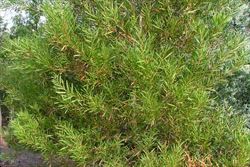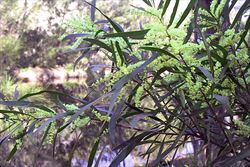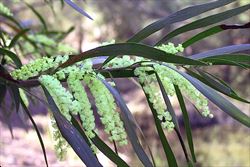Click on images to enlarge

habit (Photo: Sheldon Navie)

branches (Photo: Sheldon Navie)

elongated pale yellow flower clusters (Photo: Jackie Miles and Max Campbell)

close-up of flower clusters showing the relatively widely-spaced flowers (Photo: Jackie Miles and Max Campbell)
Scientific Name
Acacia floribunda (Vent.) Willd.
Synonyms
Acacia angustifolia Lodd.Acacia floribunda (Vent.) Willd. var. floribunda Acacia floribunda (Vent.) Willd. var. latifolia Benth.Acacia intermedia A.Cunn. ex Hook.Acacia longifolia forma floribunda (Vent.) VossAcacia longifolia var. floribunda MaidenAcacia longifolia var. floribunda (Vent.) F. Muell. ex Benth.Acacia retinodes var. floribunda H. Vilm.Mimosa floribunda Vent.Phyllodoce floribunda (Vent.) LinkRacosperma floribundum (Vent.) Pedley
Family
Fabaceae: sub-family Mimosoideae (New South Wales)Leguminosae (South Australia)Mimosaceae (Queensland, the ACT, Victoria, Tasmania, Western Australia and the Northern Territory)
Common Names
catkin wattle, gossamer wattle, river wattle, Sally wattle, white sallow, white sallow wattle, white Sally, white Sally wattle, white-sallow wattle
Origin
Native to the coastal and sub-coastal districts of eastern Australia from south-eastern Queensland to eastern Victoria. In Queensland it is mainly found from Tambourine Mountain south to the border, but there is also an isolated occurrence near Nambour on the Sunshine Coast. In New South Wales it is common in coastal districts and is occasionally also found on the Central and Northern Tablelands and nearby slopes. In Victoria it is naturally found in north-eastern areas down to near Briagolong and Sale in the Gippsland region in the south-east.
Cultivation
White Sally wattle (Acacia floribunda) has been widely cultivated in the southern parts of Australia, particularly in New South Wales and Victoria.
Naturalised Distribution
White Sally wattle (Acacia floribunda ) is naturalised beyond its native range in the southern parts of central and western Victoria. It is also naturalised in south-western Western Australia, in south-eastern South Australia and in Tasmania. It has possibly also spread beyond its original native range in New South Wales and the ACT, but this has yet to be formally recognised by herbaria in these states. For example, it has been reported by local community groups to be naturalised on Cooleman Ridge, in Canberra Nature Park, in the ACT.
This species is also naturalised in New Zealand.
Habitat
Natural populations of this species are widespread in forests and woodlands in the sub-tropical and warmer temperate regions of eastern Australia. It grows mainly in coastal eucalypt woodland communities (i.e. in wet sclerophyll forests), and is most commonly found in alluvial soils along watercourses. In the northern parts of its range (i.e. in south-eastern Queensland) it is generally found growing on slopes in cooler highland areas.
Naturalised populations of white Sally wattle (Acacia floribunda) are also generally found in eucalypt woodlands and similar habitats. However, naturalised plants seem to tolerate greater environmental extremes, because they have been reported from cooler temperate and even semi-arid climatic regions
Habit
An upright (i.e. erect) or spreading shrub or small tree growing 2-8 m tall.
Distinguishing Features
- a large shrub or small tree with alternately arranged simple 'leaves'.
- its 'leaves' are long and narrow with 1-3 prominent veins running lengthwise.
- its pale yellow or whitish flowers are loosely arranged into elongated clusters that are usually borne in pairs in the 'leaf' forks.
- its very elongated pods (up to 13 cm long and less than 5 mm wide) are constricted between each of the seeds.
Stems and Leaves
The bark on older stems is generally smooth and grey with paler blotches or horizontal streaks, but sometimes becomes rough with increasing maturity. Younger branches are reddish-brown to greenish in colour, often drooping (i.e. pendulous), and are angular or ribbed towards their tips. These younger branches are often quite hairy, but can range from densely hairy to hairless (i.e. pubescent to glabrous), and sometimes have some small whitish spots (i.e. lenticels).
The 'leaves' of this plant are actually flattened and widened leaf stalks (i.e. petioles), and not leaves in the true sense of the word. These modified leaf stalks are called phyllodes, but serve the same purpose as a regular leaf. On very young plants, partially formed phyllodes can be seen which bear twice-compound leaves at their tips. As the seedling grows, each new 'leaf' has phyllodes that are more fully formed and the leaves at their tips are eventually reduced to nothing. The green phyllodes are long and narrow (i.e. linear to narrowly lanceolate) and either straight or slightly curved (5-19 cm long and 1.5-12 mm wide). They are relatively thin and either hairless or sparsely covered with close-lying (i.e. appressed) hairs, particularly near the base of the phyllode. Each phyllode usually has one to three (rarely four) prominent parallel veins that run down most of its length and where it joins to the stem there is a short thickened structure (i.e. a pulvinus) 0.5-2.5 mm long. The tips of the phyllodes are pointed (i.e. acute) and there is sometimes an inconspicuous raised structure (i.e. gland) about 5 mm above its base.
Flowers and Fruit
The small yellow, pale yellow or whitish flowers are stalkless (i.e. sessile) and loosely arranged or scattered in elongated cylindrical clusters (i.e. spikes). These clusters (2-8 cm long) are stalkless or are borne on short stalks (i.e. peduncles) only 1-3 mm long. They emanate from the forks (i.e. axils) of the upper 'leaves' (i.e. phyllodes) and one or more often two are present in each fork. The individual flowers each have four relatively inconspicuous petals and sepals and numerous conspicuous stamens that give them a fluffy appearance. Flowering occurs mainly during late winter and early spring (i.e. from Augest to October).
The fruit is a very narrow and elongated pod (6-13 cm long and 2-5 mm wide) that is usually straight, but can occasionally be somewhat curved. These pods are constricted between each of the seeds (i.e. somewhat moniliform) and are either hairless or have a sparse covering of close-lying (i.e. appressed) hairs. They are almost rounded in cross-section (i.e. sub-cylindrical) and have ridges running down their length (i.e. they are longitudinally ridged). The pods are initially green in colour but turn brown as they mature. Seeds are oval in shape (i.e. elliptic), brown in colour, glossy in appearance (3-5 mm long and about 1.5 mm wide), and have a small fleshy structure (i.e. aril) attached to one end.
Reproduction and Dispersal
White Sally wattle (Acacia floribunda) produces numerous hard seeds, that are probably long-lived like those of other acacias. These seeds are known to be spread by animals (e.g. birds) that consume them, and are also dispersed shorter distances by ants.
Environmental Impact
This species is currently causing most concern in southern Victoria, where it is thought to pose a potential threat to one or more vegetation formations. It has spread from gardens to threaten nearby local natural areas and has been recorded from bushland in the Dandenong Ranges and the Macedon Ranges.
It is also an emerging environmental weed in Tasmania, where it is already well established in native bushland, and has been targeted for removal by Bushcare Tasmania (along with some other mainland species of wattles). Though it has also recently also become naturalised from plantings in Western Australia and South Australia, it has not created as much concern in these states to date.
White Sally wattle (Acacia floribunda) may also have spread beyond its native range in other parts of the country, as a result of escapes from garden plantings, but this is often difficult to determine with any degree of certainty, as its exact natural distribution is not completely known.
Legislation
This species is not declared or considered noxious by any state or territory government in Australia.
Similar Species
White Sally wattle (Acacia floribunda) may be confused other native species that have elongated clusters of whitish flowers and elongated pods, particularly narrow-leaf wattle (Acacia longissima) and Maiden's wattle (Acacia maidenii). Narrow-leaf wattle (Acacia longissima), from south-eastern Queensland and some parts of eastern New South Wales, can be distinguished by its longer and narrower 'leaves' (i.e. phyllodes) that are always linear in shape (6-18 cm long and 1-10 mm wide). Maiden's wattle (Acacia maidenii), from south-eastern Queensland, eastern New South Wales and eastern Victoria, can be distinguished by the very numerous prominent white spots (i.e. lenticels) on its younger branches and by its variously twisted and curled mature pods.
Note: For a more in-depth key to distinguish between all of the wattles (Acacia spp.) present in Australia, see the Wattle: Acacias of Australia CD-ROM or Flora of Australia, Volumes 11A and 11B.

